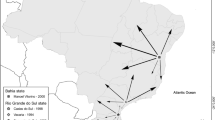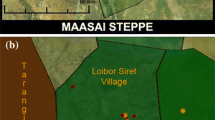Abstract
Zoological parks have been associated with an increasingly frequent origin for accidentally released animal species. Such species have become invasive in some cases. The goals of this study are to evaluate the risk of potential animal escape at zoological parks by assessing the security of animal enclosures, and to identify which factors could be affecting such security. We visited a random sample of 1,568 animal enclosures belonging to 63 Spanish zoological parks, and assessed their security with a defined criteria based on the suitability of the physical barrier of the enclosure and the impossibility for the public to release the animals. To our criteria, we found 221 enclosures which were non-secure against animal escape. Such enclosures were unevenly distributed among 47 zoological parks (74.60% of the sample), and housed non-indigenous species in 79.64% of the cases (21 species listed by the European Inventory of Invasive Species). Seven factors were analyzed to assess their effect on enclosure security. Six of them were found to have an effect, and three were selected by a logistic regression model as the main predictors for secure enclosures. Such factors are discussed, and measures are suggested to reduce the risk of zoological parks as a potential pathway for the introduction of non-indigenous species.

Similar content being viewed by others
References
AIZA (Asociación Ibérica de Zoos y Acuarios) (2008) Estatutos de la Asociación. Available from: http://www.aiza.org.es/pdf/politica/estatutos_es.pdf Accessed 26 Feb 2009
BIP (2010 Biodiversity Indicators Partnership) (2006) 2010 Biodiversity indicators partnership. UNEP, Montreal. Available from http://www.twentyten.net Accessed 30 Jan 2009
Bright C (1998) Life out of bounds: bioinvasion in a borderless world. Worldwatch Institute, Washington, D.C
Carlton JT, Ruiz GM (2005) Vector science and integrated vector management in bioinvasion ecology: conceptual frameworks. In: Mooney HA, Mack RN, McNeely JA, Neville LE, Schei PJ, Waage JK (eds) Invasive alien species: a new synthesis. Island Press, Washington, DC, pp 36–58
CBD-COP (Convention on Biological Diversity—Conference of the Parties) (2002) Alien species that threaten ecosystems, habitat or species. Conference of the Parties 6, Decision VI-23. Available from: http://www.cbd.int/decision/cop/?id=7197 Accessed 22 Feb 2010
Clergeau P, Yésou P (2006) Behavioural flexibility and numerous potential sources of introduction for the sacred ibis: causes of concern in Western Europe? Biol Invasions 8:1381–1388
Csurhes S (2003) How safe are zoos? Newsl Invasive Species Counc. 1:3
DAISIE (European Invasive Alien Species Gateway) (2008) Available from: http://www.europe-aliens.org Accessed 9 June 2009
DETR (Department of the Environment Transport and the Regions) (2000) Secretary of state’s standards of modern zoo practice. Her majesty’s stationary office, London
EAZA (European Association of Zoos and Aquaria) (2001) Resolution on invasive species. Available from: http://www.eaza.net/about/Documents/EAZA_Resolution_on_Invasive_Species_2001.pdf Accessed 16 Feb 2010
EAZA (European Association of Zoos and Aquaria) (2008) Minimum standards for the accommodation and care of animals in zoos and aquaria. Available from: http://www.eaza.net/about/Documents/Standards_2008.pdf Accessed 16 Feb 2009
Guillén-Salazar F (2003) Instrumento de Evaluación para el estudio de la situación actual de los parques zoológicos en España. Ministerio de Medio Ambiente and Universidad Cardenal Herrera, Madrid
IUCN (International Union for Conservation of Nature) (2002a) IUCN guidelines for the placement of confiscated animals. Available from: http://www.iucnsscrsg.org/download/EnglishConfGlines.pdf Accessed 18 Feb 2009
IUCN (International Union for Conservation of Nature) (2002b) IUCN technical guidelines on the management of ex-situ populations for conservation. Available from: http://intranet.iucn.org/webfiles/doc/SSC/SSCwebsite/Policy_statements/IUCN_Technical_Guidelines_on_the_Management_of_Ex_situ_populations_for_Conservation.pdf Accessed 18 Feb 2009
Jiguet F, Doxa A, Robert A (2008) The origin of out-of-range pelicans in Europe: wild bird dispersal or zoo escapes? Ibis 150:606–618
Jousson O, Pawlowski J, Zaninetti L, Zechman FW, Dini F, Di Guiseppe G, Woodfield R, Millar A, Meinesz A (2000) Invasive alga reaches California. Nature 408:157–158
Kolar CS, Lodge DM (2001) Progress in invasion biology: predicting invaders. Trends Ecol Evol 16:199–204
Lodge DM (1993) Biological invasions: lessons for ecology. Trends Ecol Evol 8:133–137
Macdonald DW, Thom MD (2001) Alien carnivores: unwelcome experiments in ecological theory. In: Gittleman JL, Funk SM, Macdonald D, Wayne RK (eds) Carnivore conservation. Cambridge University Press, Cambridge, pp 93–122
Mack RN, Simberloff D, Lonsdale WM, Evans H, Clout M, Bazzaz FA (2000) Biotic invasions: causes, epidemiology, global consequences, and control. Ecol Appl 10:689–710
Martin P, Bateson P (1993) The reliability and validity of measures. In: Martin P, Bateson P (eds) Measuring behaviour: an introductory guide. Cambridge University Press, Cambridge, pp 114–124
Mooney HA (1999) The global invasive species program (GISP). Biol Invasions 1:97–98
Parker IM, Simberloff D, Lonsdale WM, Goodell K, Wonham M, Kareiva PM, Williamson MH, Von Holle B, Moyle PB, Byers JE, Goldwasser L (1999) Impact: toward a framework for understanding the ecological effects of invaders. Biol Invasions 1:3–19
Pimentel D, Lach L, Zuniga R, Morrison D (2000) Environmental and economic costs of non-indigenous species in the United States. Bioscience 50:53–65
Pimentel D, McNair S, Janecka J, Wightman J, Simmonds C, O’Connell C, Wong E, Russel L, Zern J, Aquino T, Tsomondo T (2001) Economic and environmental threats of alien plant, animal, and microbe invasions. Agric Ecosyst Environ 84:1–20
Rodríguez-Guerra M, Guillén-Salazar F (2006) El parque zoológico, un nuevo aliado de la biodiversidad: guía para la aplicación de la Ley 31/2003 de la conservación de la fauna silvestre en los parques zoológicos. Ministerio de Medio Ambiente - Fundación Biodiversidad, Madrid
Roll U, Dayan T, Simberloff D (2008) Non-indigenous terrestrial vertebrates in Israel and adjacent areas. Biol Invasions 10:659–672
Schmitz DC, Simberloff D (1997) Biological invasions: a growing threat. Issues Sci Technol 13:33–40
Simberloff D (1996) Impacts of introduced species in the United States. Consequences 2:12–23
Spanish Ministry for the Environment (2003) Spanish catalogue of threatened species. Available from: http://www.mma.es/portal/secciones/biodiversidad/especies_amenazadas/catalogo_especies/ Accessed 22 Feb 2009
UNEP (United Nations Environmental Programme) (2004a) Indicators for assessing progress towards the 2010 target: numbers and costs of alien invasions. UNEP/CBD/SBSTTA/10/INF/17. UNEP, Montreal
UNEP (United Nations Environmental Programme) (2004b) Provisional global indicators for assessing progress towards the 2010 biodiversity target. UNEP/CBD/COP/7/INF/33. UNEP, Montreal
UNEP (United Nations Environmental Programme) (2005) Report of the subsidiary body on scientific, technical and technological advice on the work of its tenth meeting. UNEP/CBD/COP/8/2. UNEP, Brazilia
Vitousek PM, Dantonio CM, Loope LL, Rejmanek M, Westbrooks R (1997) Introduced species: a significant component of human-caused global change. New Zealand J Ecol 21:1–16
Walker B, Steffen W (1997) An overview of the implications of global change for natural and managed terrestrial ecosystems. Conserv Ecol 1:2
WAZA (World Association of Zoos and Aquaria) (2005) Building a future for wildlife: the world zoo and aquarium conservation strategy. WAZA, Bern
Williamson M (1996) Biological invasions. Chapman and Hall, London
Acknowledgments
We thank the Spanish Ministry for the Environment for funding the broader study that generated the data we used in this paper. We also want to thank the participating zoos for their assistance during this study. The manuscript greatly benefited from comments from Dr. V. Rodilla (Universidad Cardenal Herrera, Spain) and Dr. S. Sánchez-Peña (Universidad Autónoma Agraria Antonio Narro, México), as well as from those made by two anonymous referees.
Author information
Authors and Affiliations
Corresponding author
Appendix 1
Appendix 1
Questions regarding the security of the enclosures against animal escape included in the data sheets used by the evaluators when assessing enclosure security (from Guillén-Salazar 2003). For the purpose of this study an enclosure was considered “secure” only when both conditions were simultaneously met. Otherwise the enclosure was categorized as “non-secure”.
Condition 1
The enclosure has a complete, well maintained, and appropriate physical barrier to prevent the escape of the animals housed within (including sewage lines, filtration systems and, in general, any opening or valve that could allow the escape of an animal or part of it such as eggs). Each of the following questions should be answered negatively to meet this condition.
-
a.
Could the barrier be knocked down by the animals held in the enclosure?
-
b.
Could the animals exit the enclosure by leaping or climbing the barrier (including the use of vegetation, tools, etc.)?
-
c.
Could the animals escape by digging under the barrier?
-
d.
Could the animals go through the barrier (especially young individuals)?
-
e.
Are there any pipes or ducts (sewage lines, water channels, etc.) in the enclosure that could allow the escape of the animals held in it?
-
f.
In the case of being a drive through or walk through enclosure, a double gate entry and exit system should be in place with sufficient space to allow the gates to be securely closed at the front and rear of any vehicle (or person) which may enter or need to enter the enclosure. Could the animals held inside exit the enclosure through any of the gates?
-
g.
Could the integrity of the barrier be compromised by any external factor (e.g. a fallen tree on the barrier)?
Condition 2
The public cannot release the animals held at the enclosure directly or indirectly. Each of the following questions should be answered negatively to meet this condition.
-
a.
Could the public capture the animals and remove them from the enclosure?
-
b.
Are there any doors or windows that could be opened by the public due to lack of continuous supervision by zoo personnel and/or because they are not properly locked?
-
c.
Are there any objects surrounding the enclosure such as rocks, branches or forgotten tools that could be used to free the animals held at the enclosure (e.g. by tearing down the fences comprising the physical barrier of the enclosure)? Note: Violations with premeditation, planning and preparation that could be considered as an offense are not considered.
Rights and permissions
About this article
Cite this article
Fàbregas, M.C., Guillén-Salazar, F. & Garcés-Narro, C. The risk of zoological parks as potential pathways for the introduction of non-indigenous species. Biol Invasions 12, 3627–3636 (2010). https://doi.org/10.1007/s10530-010-9755-2
Received:
Accepted:
Published:
Issue Date:
DOI: https://doi.org/10.1007/s10530-010-9755-2




